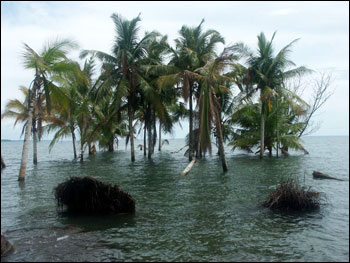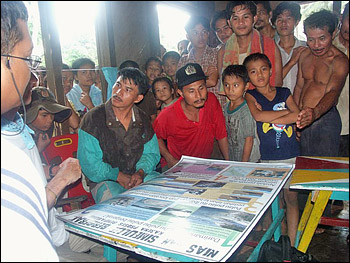

Generating New Questions | |||
According to Meltzner, one of the most interesting results of the uplift/subsidence mapping in the region came when he and colleagues combined the results from the 2004 quake with observations from a second quake, which struck in March 2005 just to the south of the 2004 one. “What it looks like,” said Meltzner, “is that the 2004 rupture propagated into Simeulue Island from the north, and then the 2005 rupture propagated into Simeulue from the south. There was about a meter and half of uplift in the north in 2004, and a net of about a meter and half in the south from the 2004 and 2005 quakes combined. But in the middle of Simeulue, on the west coast, there was only a half a meter of uplift. That raised some very intriguing questions about why this saddle, or gap, exists.” |
|||

He says there are several possible explanations for the saddle, some more benign than others. It could be that a large earthquake in the recent past had released all the strain between the plates at that location, although the historical records that exist don’t reveal such a quake, so that hypothesis appears unlikely. “Another hypothesis, which is alarming if true,” Meltzner said, “is that we don’t know why it didn’t slip, but now it is ready to.” The third possibility, which Meltzner favors, is that the area may be what they call an “aseismic patch” in the fault, where for whatever reason, the two plates glide past each other without sticking. Little stress builds up, so no big earth movement occurs there. If the hypothesis about the aseismic patch in the middle of Simeulue proves to be correct, it could be important for predicting future quakes in the area. “It would mean that it is very difficult for earthquakes to pass through that region,” Meltzner explained, “so it would be very difficult to generate an earthquake bigger [in length] than the 2004 earthquake because it would run out of steam at that point.” |
After the Aceh quake, some areas remained below the water line, thanks to a combination of subsidence and local ground slumping. These palm trees on the east coast of Nias Island were submerged due mainly to ground slumping. (Photo copyright © Aron Meltzner.) | ||

Meltzner says that one of the things that appeals to him most about science is how it provides endless opportunities to apply both your intelligence and your creativity to solve puzzles about how the world works. Before this study, he had never thought of using satellite data to study earthquakes in this way. But when the data you want—say, a GPS station every 10 kilometers in the Andaman Islands—doesn’t exist, you look for clues wherever you can find them, for example, in the pinkish hue of a coral reef in a false-color photo taken from hundreds of kilometers away in outer space. Meltzner’s results from this study were folded into a comprehensive analysis of the quake that appeared in the prestigious journal Nature in early 2006. Similar research on the 2005 quake was published in Science. Getting published in Nature or Science is an achievement even veteran scientists take pride in. For a graduate student at the start of his career, it’s probably even more exciting. But the best reward of his research is the reception he has gotten in places all over the world where he has gone to study earthquakes. |
While some trees languished under water, some corals died from their lack of it. These corals along shore of uninhabited Babi Island were thrust up by the quake and remained above the water line. (Photo copyright © Aron Meltzner.) | ||

“People are just so warm and welcoming and happy to see us. I have repeatedly come across people who have lost their houses, who have lost family members, who have lost almost everything they have, and yet they would be willing to give us shelter, give us food, give us anything that we want. It is such an incredible feeling to see that what you are working on—in addition to being published in scientific literature, which is, of course, very important—has the potential to make a direct improvement in people’s lives.”
|
When Meltzner visited the Sumatra area in 2005, locals enthusiastically shared their knowledge of the quake with him and his colleagues. (Photo Copyright © Aron Meltzner.) | ||